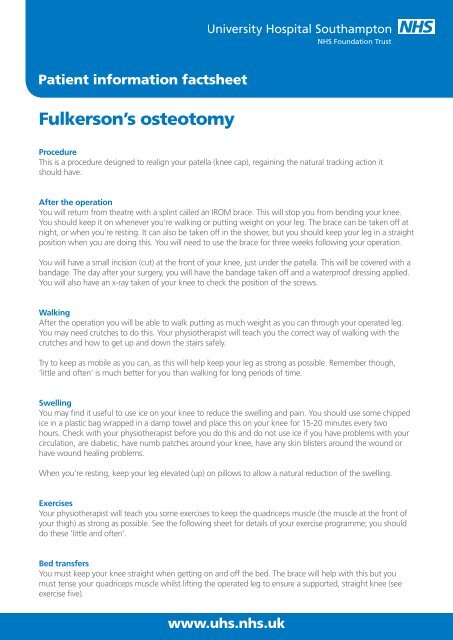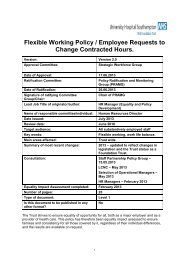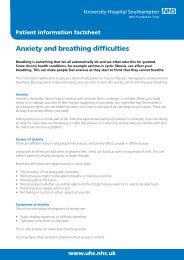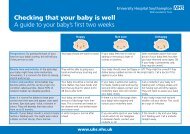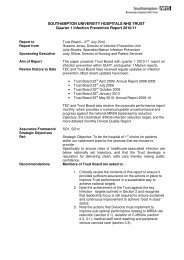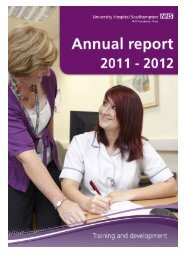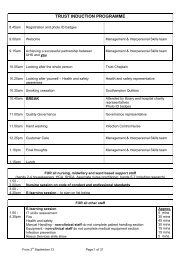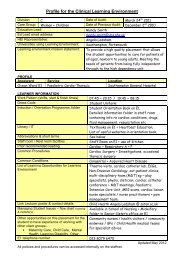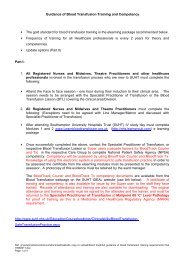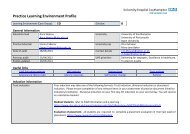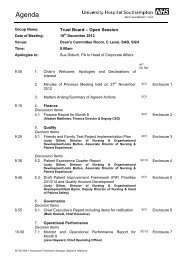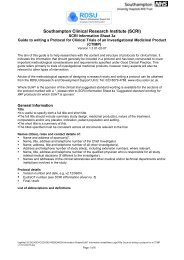Fulkerson's osteotomy - patient information
Fulkerson's osteotomy - patient information
Fulkerson's osteotomy - patient information
- No tags were found...
You also want an ePaper? Increase the reach of your titles
YUMPU automatically turns print PDFs into web optimized ePapers that Google loves.
Patient <strong>information</strong> factsheetFulkerson’s <strong>osteotomy</strong>ProcedureThis is a procedure designed to realign your patella (knee cap), regaining the natural tracking action itshould have.After the operationYou will return from theatre with a splint called an IROM brace. This will stop you from bending your knee.You should keep it on whenever you’re walking or putting weight on your leg. The brace can be taken off atnight, or when you’re resting. It can also be taken off in the shower, but you should keep your leg in a straightposition when you are doing this. You will need to use the brace for three weeks following your operation.You will have a small incision (cut) at the front of your knee, just under the patella. This will be covered with abandage. The day after your surgery, you will have the bandage taken off and a waterproof dressing applied.You will also have an x-ray taken of your knee to check the position of the screws.WalkingAfter the operation you will be able to walk putting as much weight as you can through your operated leg.You may need crutches to do this. Your physiotherapist will teach you the correct way of walking with thecrutches and how to get up and down the stairs safely.Try to keep as mobile as you can, as this will help keep your leg as strong as possible. Remember though,‘little and often’ is much better for you than walking for long periods of time.SwellingYou may find it useful to use ice on your knee to reduce the swelling and pain. You should use some chippedice in a plastic bag wrapped in a damp towel and place this on your knee for 15-20 minutes every twohours. Check with your physiotherapist before you do this and do not use ice if you have problems with yourcirculation, are diabetic, have numb patches around your knee, have any skin blisters around the wound orhave wound healing problems.When you’re resting, keep your leg elevated (up) on pillows to allow a natural reduction of the swelling.ExercisesYour physiotherapist will teach you some exercises to keep the quadriceps muscle (the muscle at the front ofyour thigh) as strong as possible. See the following sheet for details of your exercise programme; you shoulddo these ‘little and often’.Bed transfersYou must keep your knee straight when getting on and off the bed. The brace will help with this but youmust tense your quadriceps muscle whilst lifting the operated leg to ensure a supported, straight knee (seeexercise five).www.uhs.nhs.uk
Patient <strong>information</strong> factsheetOut<strong>patient</strong> appointmentsYou will return to clinic to see your surgeon six weeks after your operation.You will also have been referred from the hospital to be seen by the physiotherapists as an out<strong>patient</strong>, startingfrom three weeks after your operation. They will advise you about weaning yourself out of the brace andshow you more exercises to help you start moving your knee again and build up the strength in your leg. Youwill need to continue with your physiotherapy until your knee is bending properly and you have managed toregain the strength in your leg.DrivingTo return to driving, you must have sufficient range of movement and muscle control of the knee to safelycontrol the car and perform an emergency stop. This is likely to be between six and 12 weeks after surgery.Please liaise with your physiotherapist or consultant regarding your suitability to drive again.SportYour return to sporting activities will depend on the sport and how quickly you regain range of movement ofthe knee joint and adequate muscle control. Sports-specific rehabilitation can start around 12 weeks followingsurgery. Please liaise with your physiotherapist regarding your sporting goals.www.uhs.nhs.uk
Patient <strong>information</strong> factsheetExercises following aFulkerson’s <strong>osteotomy</strong>Try to complete the exercises at least three times daily.Keep your foot elevated to decrease swelling.Apply ice, wrapped in a pillowcase or tea towel, to your knee for ten to 15 minutes every hour.1. Lie on your back and move your ankle up and down, wigglingyour toes.Repeat 15 times.2. Lie on the bed and squeeze your buttocks together.Hold for five seconds.Repeat 15 times.3. Lie on your back, pull your toes towards you and brace your kneesdown firmly against the bed. Hold for ten seconds.Repeat 15 times.4. Sit up in bed with your legs straight out in front of you. Place yourfingers on the outside edge of your knee cap and gently guide yourknee cap to the inner side of your leg (towards your un-operatedknee).Repeat 30 times.Don’t push your knee cap to the outside of your leg.Don’t do this as an exercise in itself, but just as a method to get inand out of bed.5. Pull your toes towards you and tighten the muscles on the front ofyour thigh to maintain a straight knee; then lift your leg off the bed.www.uhs.nhs.uk
Patient <strong>information</strong> factsheetContact detailsIf you have any questions about Fulkerson’s <strong>osteotomy</strong>, please contact us at:Orthopaedic physiotherapy teamSouthampton General HospitalTremona RoadSouthamptonSO16 6YDTel: 023 8079 4452If you need a translation of this document,an interpreter or a version in large print,Braille or on audio tape, please telephone023 8079 4688 for help.Revised Sept 12 Review date Sept 2015. THY 001.24www.uhs.nhs.uk


